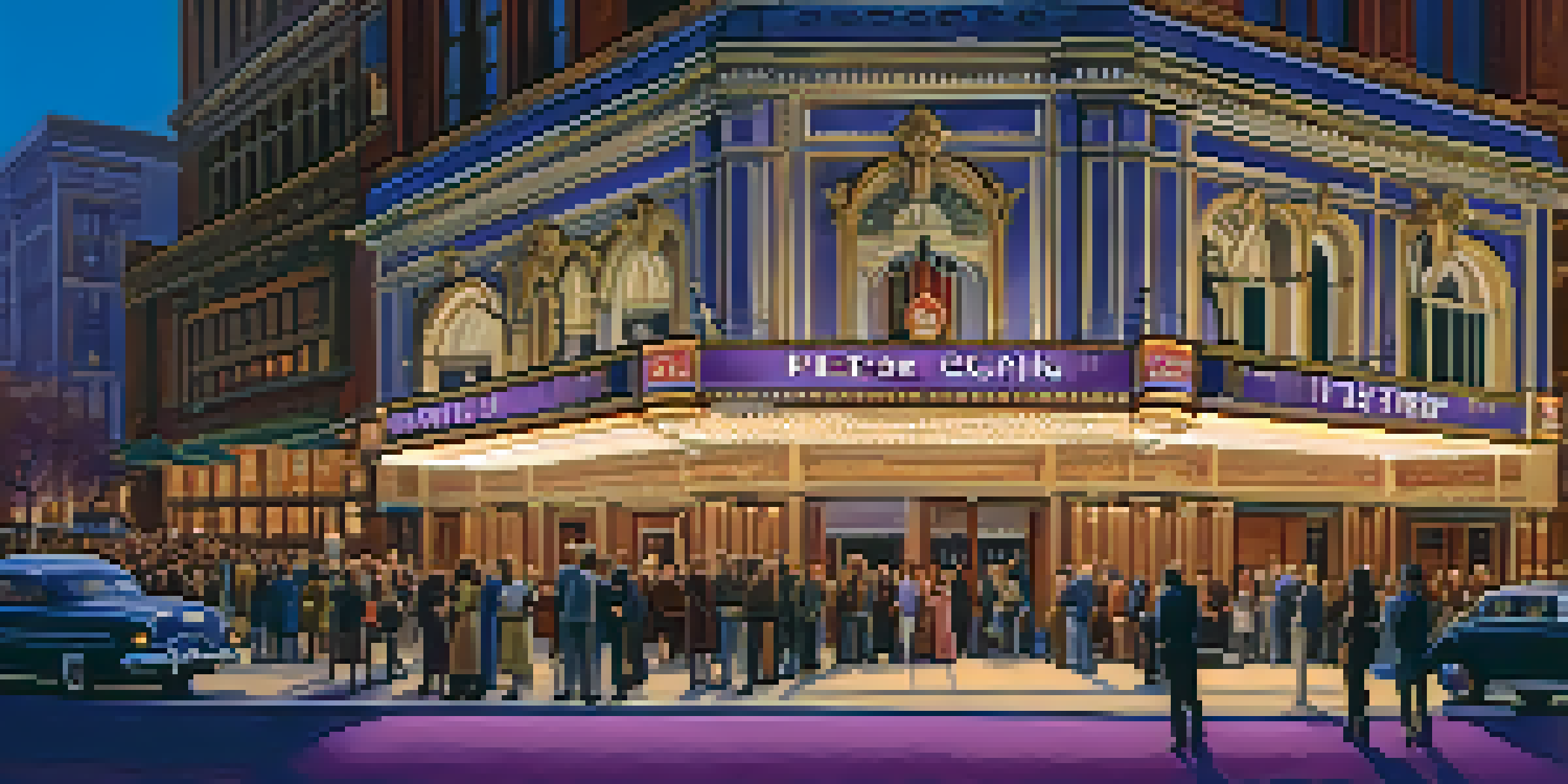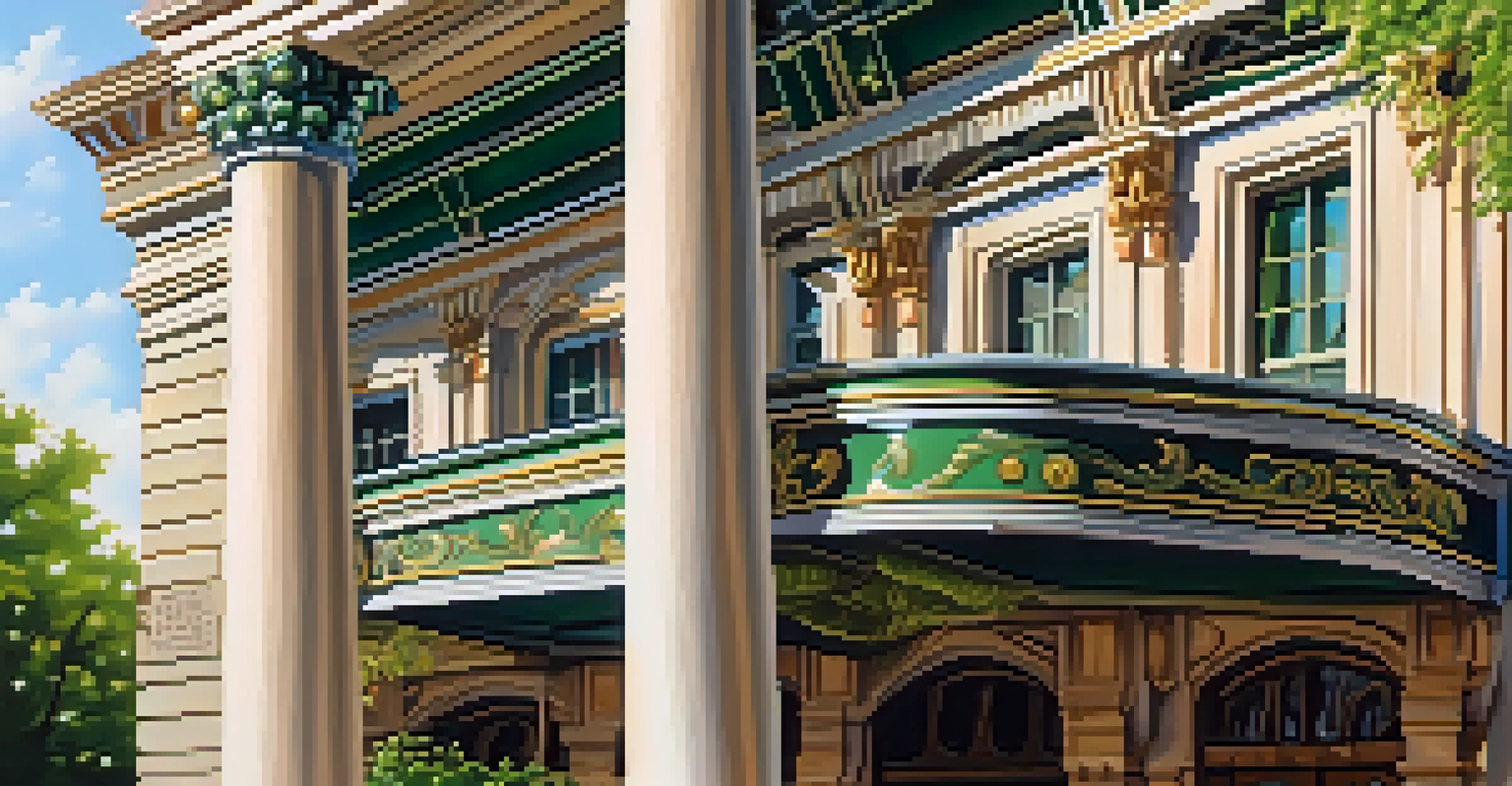Historic Theaters: A Journey Through the City’s Cultural Past

The Significance of Historic Theaters in Our Culture
Historic theaters are more than just buildings; they are living museums that encapsulate the cultural essence of a city. These venues have hosted countless performances, from classic plays to modern musicals, each leaving a mark on the community's artistic landscape. They serve as a reminder of the artistic expressions and historical narratives that have shaped our society.
The theater is a place where we can all come together to celebrate our humanity.
The architecture of these theaters often reflects the time period in which they were built, showcasing intricate designs that tell stories of their own. For instance, the ornate embellishments and grand facades of theaters from the early 20th century evoke a sense of nostalgia and grandeur. This aesthetic beauty draws both locals and tourists, making theaters a vital part of the city's identity.
Beyond their physical presence, historic theaters foster a sense of community and belonging. They bring people together, creating shared experiences that bridge generations. Whether it’s the anticipation of a live performance or the joy of a classic film, these venues remain central to our cultural gatherings.
A Brief History of Theaters in Our City
The history of theaters in our city dates back to the late 19th century, when vaudeville shows and silent films first took the stage. As entertainment evolved, so did the theaters, adapting to the changing tastes of the public. Many of these venues were designed to be grandiose, attracting both performers and audiences alike.

Throughout the decades, theaters have mirrored societal changes, reflecting cultural shifts and movements. For example, during the Great Depression, many theaters turned to affordable entertainment, providing a much-needed escape for struggling families. This adaptability has allowed them to survive through tumultuous times.
Cultural Significance of Theaters
Historic theaters serve as living museums that encapsulate a city's artistic and cultural essence.
Today, some of these historic theaters are recognized as landmarks, preserving their legacy while continuing to host diverse performances. They remind us of our past and influence the future of performing arts in the city, making theater history an integral part of our cultural narrative.
Architectural Marvels: The Designs of Historic Theaters
The architectural styles of historic theaters vary widely, showcasing the creativity of different eras. From the lavish Art Deco designs to the more understated Gothic Revival, each theater tells a unique story through its structure. These buildings often feature stunning interiors, complete with ornate ceilings and plush seating that enhance the audience's experience.
Historic theaters are not just venues; they are the heartbeats of our communities, reminding us of our shared stories.
Many theaters were constructed using local materials, making them a reflection of the surrounding landscape and culture. For instance, a theater built in a coastal city might incorporate nautical themes into its design. This local influence adds a layer of authenticity and pride to these venues.
Preserving these architectural marvels is crucial, not only for historical value but also for the community's identity. Restoration efforts often focus on maintaining original features while updating facilities to meet modern needs, striking a balance between honoring the past and embracing the future.
The Role of Historic Theaters in Community Engagement
Historic theaters play a pivotal role in fostering community engagement and artistic collaboration. They often serve as a platform for local artists and performers, providing opportunities for creative expression that might not otherwise be available. This support helps nurture emerging talent and enriches the local arts scene.
Events hosted at these theaters, such as film festivals, performances, and community gatherings, create a sense of belonging among residents. They encourage interaction and collaboration across diverse groups, strengthening community ties. Theaters become a hub of activity, drawing people together for shared experiences.
Community Engagement and Support
These venues foster community ties and provide platforms for local artists, enriching the local arts scene.
Furthermore, many historic theaters implement educational programs to engage younger audiences. Workshops, school performances, and outreach initiatives introduce students to the arts, ensuring that future generations appreciate the significance of theater in their community.
Challenges Facing Historic Theaters Today
Despite their cultural significance, historic theaters face numerous challenges in today's rapidly changing entertainment landscape. Competition from streaming services and digital media has made it difficult for traditional theaters to attract audiences. Many are struggling to adapt to these new trends while maintaining their unique charm.
Financial sustainability is another pressing issue. With rising maintenance costs and dwindling resources, some theaters are forced to close their doors or cut back on programming. This not only impacts the venues themselves but also the local artists and communities that rely on them for support.
Preserving the historical integrity of these theaters while modernizing facilities presents a delicate balance. Finding funding for restoration projects and upgrades can be a daunting task, yet it’s essential for ensuring that these cultural landmarks continue to thrive.
The Impact of Restoration and Preservation Efforts
Restoration and preservation efforts play a crucial role in maintaining the legacy of historic theaters. These initiatives often involve a team of architects, historians, and community members working together to restore the venue to its former glory. Such projects not only revitalize the building but also reinvigorate community interest in the arts.
Successful restoration can lead to increased attendance and a renewed sense of pride among residents. When a historic theater is lovingly cared for, it becomes a source of inspiration and connection, reminding people of their cultural heritage. This renewed interest often encourages local businesses to engage and support the arts, creating a vibrant ecosystem.
Challenges and Future Adaptation
Historic theaters face challenges from digital media and financial issues, necessitating innovative solutions for sustainability.
Moreover, preserved theaters often attract tourism, contributing to the local economy. Visitors are drawn to the unique experience of attending performances in historical venues, further highlighting the importance of preserving these cultural treasures.
Looking Ahead: The Future of Historic Theaters
As we look to the future, the role of historic theaters will continue to evolve. Embracing technology, many venues are integrating digital elements to enhance the audience experience while maintaining their historical charm. This fusion of old and new creates exciting opportunities for innovation in the performing arts.
Community involvement will also be key to the sustainability of these theaters. By fostering strong relationships with local residents, businesses, and artists, historic theaters can cultivate a loyal audience base that values their cultural contributions. Collaborative programming and outreach initiatives will help ensure these venues remain relevant.

Ultimately, the future of historic theaters hinges on a collective commitment to preserving their unique heritage while adapting to contemporary needs. By balancing tradition with innovation, these cultural landmarks can continue to thrive as vital parts of our community for years to come.